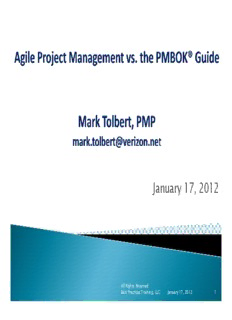
Presentation Slides: APM versus the PMBOK Guide and - pmiwdc PDF
Preview Presentation Slides: APM versus the PMBOK Guide and - pmiwdc
January 17, 2012 All Rights Reserved Best Practices Training, LLC January 17, 2012 1 Agile has now become mainstream, and there are two dominant approaches for managing projects: ◦ Traditional Projject Managgement – ((TPM)) - Best represented by the PMBOK® Guide using Earned Value Method – EVM) ◦ Agile Project Management – (APM) Was first used primarily for software projects. Now, it is being used in many other new product and service development areas. JJaannuuaarryy 22001122 – PPMMNNeettwwoorrkk MMaaggaazziinnee ◦ 90% of Software PMs that were interviewed said they were using some form of Agile ◦ UUssee ooff AAggiillee hhaass ttrriipplleedd ffrroomm DDeecceemmbbeerr 22000088 ttoo MMaayy 22001111 ◦ Most PMs using Agile cite much higher success rates All Rights Reserved Best Practices Training, LLC January 17, 2012 2 Individuals and interactions over processes and tools Working software over comprehensive documentation CCuussttoommeerr ccoollllaabboorraattiioonn oovveerr ccoonnttrraacctt nneeggoottiiaattiioonn Responding to change over following a plan That is, while there is value in the items on the right, we value the items on the left more. All Rights Reserved Best Practices Training, LLC January 17, 2012 3 Scrum XP – (Extreme Programming) Lean Crystal DDSSDDMM – ((DDyynnaammiicc SSyysstteemmss DDeevveellooppmmeenntt MMeetthhoodd)) FDD – (Feature Driven Development) All Rights Reserved Best Practices Training, LLC January 17, 2012 4 Most authors of books & articles on Agile say “NO!” ◦ AAggiillee ddeeffiinneess aa rreevvoolluuttiioonnaarryy aapppprrooaacchh ttoo mmaannaaggiinngg pprroojjeeccttss.. IItt iiss diametrically opposed to the practices described in TPM! Doug DeCarlo – “Extreme Project Management” ◦ If TPM is classical music ‐ Agile is jazz ◦ IIff TTPPMM iis cllassiicall, NNewttoniian phhysiics ‐ AAgiille iis QQuanttum MMechhaniics ◦ Cites a quote from a PMP managing pension implementations: ◦ “I always believed that the project management profession is doing itself a disservice if it doesn't recognize that many, if not most, projjects ddon''t ffollllow thhe guiiddelliines set fforthh bby PPMMII''s PPMMBBOOKK®® Guide.” (Other references): ◦ Jim Higghsmith – “Aggile Projject Managgement: Creatingg Innovative Products” ◦ Ken Schwaber – “Agile Project Management with Scrum” All Rights Reserved Best Practices Training, LLC January 17, 2012 5 The PMI View – “Yes, of course, the two approaches are ccoommppaattiibbllee!!” ◦ The PMBOK® Guide defines a high‐level framework of best practices for managing projects in any industry, no matter how simple or how complex. ◦ Attaching to this framework, there can be many more specific methodologies and approaches that can be used. Agile Project Management defines such a group of more specific methodologies. From pmi.org – FAQ page on the new PMI‐ACP certification: “The PMBOK® Guide – Fourth Edition contains principles of project management and project management processes. These processes describe “what should be done during the management of a project.’ Agile methodologies are different in that they describe ‘how to do the things that should be done’ – in short, ‘what versus how’.” All Rights Reserved Best Practices Training, LLC January 17, 2012 6 “WWaatteerrffaallll” – DDiivviiddee tthhee pprroojjeecctt iinnttoo aa sseett ooff sseeqquueennttiiaall phases. Term coined by Winston Royce – 1970. (He was really criticizing the Waterfall Method in his article!) All Rights Reserved Best Practices Training, LLC January 17, 2012 7 • WWe wiillll organiize tthhe phhases iin a sequenttiiall manner ((or “Waterfall” structure.) Conceptual Design Detailed Design Development Unit Testing IInntteeggrraatteedd Testing Phases All Rights Reserved Best Practices Training, LLC October 31, 2011 8 CCuussttoommeerr ddooeessnn’tt sseeee tthhee pprroodduucctt oorr aapppplliiccaattiioonn ffoorr 11‐22 years In that time, their requirements have changed! (The world has kept moving.) It’s not until they really get to see and use the product that tthheeyy uunnddeerrssttaanndd wwhhaatt tthheeyy rreeaallllyy nneeeeddeedd iinn tthhee ffiirrsstt ppllaaccee It’s not until they really get to see and use the product that we learn if we understood their requirements properly! Therefore, we often have some of the things we hate the most: Scope Creep, Schedule Delays, Cost Overruns, … ((AAnndd aa nneeww PPrroojjeecctt MMaannaaggeerr!!)) All Rights Reserved Best Practices Training, LLC January 17, 2012 9 WWee wwiillll uussee aann iitteerraattiivvee aapppprrooaacchh:: ((IItteerraattiioonnss oorr SSpprriinnttss ttoo build prototypes) ◦ The “Product Owner” defines the “Product Backlog” ◦ From this, an initial subset of the backlog is chosen for the first iteration – (Sprint) ◦ Very quickly: ‐ within an iteration of 2 weeks to 4 weeks we will create an initial prototype ((Sprint Backlog)) off core ffeatures//stories. ◦ At the end of each iteration the prototype is reviewed, and the team goes through a “review” or “adaptive” process. ◦ A backlog is chosen for the next iteration ◦ We iteratively keep going through this process of “exploring, discovering, and adapting” – progressively elaborating the prototypes ‐ andd creatiing true vallue ffor thhe customer. WWe llet thhe requirements “emerge.” All Rights Reserved Best Practices Training, LLC January 17, 2012 10
Description: